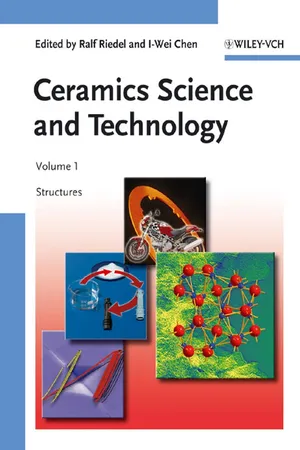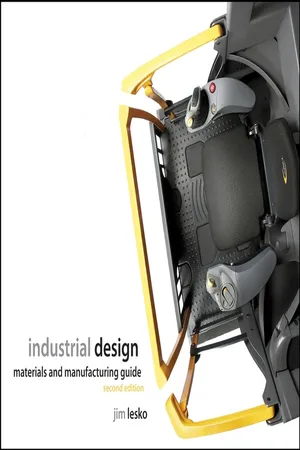Ceramic Materials
Ceramic materials are inorganic, non-metallic compounds that are known for their high melting points, hardness, and excellent electrical and thermal insulation properties. They are commonly used in a wide range of applications, including in the production of pottery, bricks, tiles, and advanced engineering ceramics for industries such as aerospace, automotive, and electronics.
6 Key excerpts on "Ceramic Materials"
- eBook - ePub
- Ralf Riedel, I-Wei Chen, Ralf Riedel, I-Wei Chen(Authors)
- 2015(Publication Date)
- Wiley-VCH(Publisher)
...I Introduction 1 Modern Trends in Advanced Ceramics Ralf Riedel, Emanuel Ionescu, and I.-Wei Chen 1.1 Advanced Ceramics Ceramics are defined as inorganic, non-metallic materials which are typically crystalline in nature and contain metallic and non-metallic elements such as Al 2 O 3, CaO, ZrO 2, SiC, and Si 3 N 4. There are several broad categories of ceramics classifying the industrial products as follows: clay products, white ware, refractories, glasses, cements, abrasives, and advanced ceramics. Advanced ceramics are materials tailored to possess exceptional properties (superior mechanical properties, corrosion/oxidation resistance, thermal, electrical, optical or magnetic properties) by controlling their composition and internal structure. They are subdivided into structural ceramics (wear parts, cutting tools, engine components and bioceramics), electrical ceramics (capacitors, insulators, substrates, integrated circuit packages, piezoelectrics, magnets and superconductors), ceramic coatings (engine components, cutting tools and industrial wear parts) and chemical processing and environmental ceramics (filters, membranes, catalysts and catalyst supports). As an example of advanced ceramics, silicon carbide (SiC) bearings for chemical plants are shown in Figure 1.1. This type of device must withstand aggressive chemical environments, show high compressive strength, high stiffness, low density, high fracture resistance, and remain stable under thermal stress. 1.2 Conventional Synthesis and Processing of Advanced Ceramics 1.2.1 Synthesis of Ceramic Powders The preparation of ceramic products typically involves heating processes of ceramic powders which must undergo special handling in order to control purity, particle size, particle size distribution, and heterogeneity. These factors play an important role in the properties of the finished ceramic part...
...4 Ceramic Materials 4.1 Introduction The term ‘ceramics’ covers a range of materials that all have a similar range of properties and behaviour, but may vary in their origin and appearance. Ceramics can cover natural as well as artificial materials, e.g. minerals, rocks, cement gels and glasses, as well as sintered clays which give us our traditional ceramics. Traditional ceramics are made from clays which are fired to give pottery, bricks and tiles. They are a combination of flint, feldspar and clay. Modern ceramics have the following characteristics: They are inorganic They have non-metallic properties (but metallic elements may be present) They are ionically and covalently bonded They often contain a combination of metal and oxygen atoms (or more generally gaseous and metallic elements, e.g. nitrogen can be substituted for oxygen in many aluminosilicates; they are then called ‘sialons’) They are also often: Hard Good thermal insulators (good fire resistance) Good electrical insulators Chemically stable Brittle Of high compressive strength Multi-phase materials The Ceramic Materials used in building exhibit all these properties. The advantages of using many Ceramic Materials is that are already environmentally stable and will not oxidise further in the atmosphere. Unlike metals, which generally exist in an unstable state and must be protected, ceramics are unlikely to react with elements in the atmosphere and are normally used in their natural state, i.e. their body composition can be their finished skin. This makes them economic in terms of maintenance. Problems are more likely to occur when they are combined with other materials to give different properties. For example when concrete is used in combination with steel to improve its tensile strength by making a composite, carbonation and the subsequent corrosion of the re-inforcement will make the whole material unstable. Mechanical fixing details generally are also a source of failure...
- eBook - ePub
- S.K. Duggal(Author)
- 2017(Publication Date)
- Routledge(Publisher)
...Chapter 14 Ceramic Materials 4.1 Introduction 4.2 Classification of Trees 4.3 Growth of Trees 4.4 Classification of Timber 4.5 Structure of Timber 4.6 Characteristics of Good Timber 4.7 Seasoning of Timber 4.8 Defects of Timber 4.9 Diseases of Timber 4.10 Decay of Timber 4.11 Preservation of Timber 4.12 Fire Resistance of Timber 4.13 Testing of Timber 4.14 Suitability of Timber for Specific Uses 4.15 Properties of Wood 4.16 Wood Products Exercises 14.1 Introduction Ceramics refer to polycrystalline materials and products formed by baking natural clays and mineral admixtures at a high temperature and also by sintering oxides of various metals and inorganic substances having high melting point. The word is of Greek origin and derives its name from Keromos meaning potter’s earth or clay. But, nowadays the term ceramic is applied to a wide range of silicates, metallic oxides and their combinations. Carbon, boron, silicon, certain carbides, silicates, refractory hydrides and sulphides are also considered to be ceramics. As a building material, ceramics, may include brick, stone, concrete, glass, abrasives, porcelain, high temperature refractories, etc. Clay is the most common example of Ceramic Materials. Magnesium oxide can withstand high temperatures (1650-2500°) without melting and is used extensively as a refractory. Ceramics are usually hard and brittle and are in the form of amorphoys (non-crystalline) or glassy solids. The bond in these materials is mixed ionic and covalent and while these can be made in single crystal forms, their more common structure is glassy. Because of covalent ionic bond the electrons are not free which makes the ceramics, thermal and electrical insulators. At low temperatures, ceramics behave elastically. However, under proper conditions of stress and temperature these deform by viscous flow. 14.2 Classification of Ceramic On the basis of their internal structure the ceramics are classified as clay products, refractories and glasses...
- eBook - ePub
- W. Bolton, R.A. Higgins(Authors)
- 2014(Publication Date)
- Routledge(Publisher)
...21 Ceramics 21.1 Introduction The term ceramics is derived from the Greek keramos - 'potter's clay'. Gradually, this term has been extended to include all products made from fired clay, such as bricks, tiles, fireclay refractories, wash-hand basins and other sanitary ware, electrical porcelains and ornaments, as well as pottery tableware. Many substances now classed as ceramics in fact contain no clay though most are relatively hard, brittle materials of mineral origin with high fusion temperatures. Thus, hydraulic cement is usually classed as a ceramic material, whilst a number of metallic oxides such as alumina, magnesia, zirconia and beryllia form the basis of high-temperature ceramic refractories. Some of the latter, in particular alumina and zirconia, along with recently developed materials like silicon nitride and the 'sialons', boron nitride and boron carbide, have more sophisticated uses. Ceramics can be grouped as: Domestic ceramics, e.g. china, earthenware, stoneware and cement. Natural ceramics, e.g. stone. Engineering ceramics, e.g. alumina, zirconia, boron nitride, etc. which are widely used in engineering as furnace components, tool tips and grinding tools. Glasses and glass ceramics. Most of the ceramics materials mentioned earlier are either completely crystalline in structure or are a mixture of crystalline regions cemented together by an infilling of amorphous networks. Glasses, on the other hand, are materials which, at ambient temperatures, are still in an amorphous state, i.e. they are virtually still in a liquid condition. Glass comprises a range of substances, from boiled sweets to window panes and beer tankards. Glass ceramics are fine-grained polycrystalline materials produced by the controlled crystallisation of glasses. Glasses are discussed in more detail in Chapter 22. Electronic materials, e.g...
- eBook - ePub
Industrial Design
Materials and Manufacturing Guide
- Jim Lesko(Author)
- 2011(Publication Date)
- Wiley(Publisher)
...Ceramic engine components permit efficient burning of fuel at higher temperatures and eliminate the need for a cooling system. Other uses are cutting tools, valves, bearings, and chemical processing equipment. In the electronics industry, Ceramic Materials are used for chips, superconductors, magnets, capacitors, and transducers. The cost is low because there are abundant raw materials for making ceramics. Brittleness is a problem in using these materials, but new combinations with reinforcing fibers or whiskers have increased ductility and toughness of Ceramic Materials. Metal Oxide Ceramics Aluminas serves at 3,000°F but with limited thermal shock/ impact resistance and poor performance in corrosive atmospheres. Beryllia resists thermal shock and has a low coefficient of thermal expansion and high thermal conductivity. Zirconia is inert to most metals with the highest strength to 4,000°F. Glass Ceramics Glass ceramics are used for consumer and commercial cooking vessels, tableware, cooktops and radomes for microwave ovens as well as for industrial and technical applications. These ceramics are formed from molten glass and then crystallized by heat treatment. The common glass ceramics, lithium-aluminum-silicate, magnesium-aluminum-silicate, and aluminum-silicate, are composed of oxides that form complex, multiphase microstructures; have near zero coefficients of thermal expansion, and resist high temperature corrosion. Macor by Corning can be machined with conventional tools and has the strength of alumina and many high temperature and electrical properties of the other glass ceramics. A photosensitive glass ceramic can be chemically machined and used for harddrive read/write heads, wire guides for dot matrix printers, cell sheets for gas discharge displays, and substrates for thick film and thin film metallization...
- eBook - ePub
- Zohaib Khurshid, Shariq Najeeb, Muhammad Zafar, Farshid Sefat(Authors)
- 2019(Publication Date)
- Woodhead Publishing(Publisher)
...4 Ceramic Materials in dentistry James K.H. Tsoi, Dental Materials Science, Discipline of Applied Oral Sciences, Faculty of Dentistry, The University of Hong Kong, Pokfulam, Hong Kong SAR, P.R. China Abstract This chapter focuses on some ceramics that are being used in contemporary dentistry. Besides the basic technology and science parts, some specific aspects including classification, adhesion, and biological interaction are emphasized. Readers are anticipated to learn some basics about modern dental ceramics and also can go into details by reading from other resources as highlighted in italics with some of the words and terms. Keywords Ceramics; dentistry; glass ceramics; oxide ceramics; zirconia Chapter Outline 4.1 Introduction 55 4.1.1 Glass ceramics 56 4.1.2 Oxide ceramics 61 4.1.3 Polymer-containing ceramics 64 4.2 Ceramic bonding 65 4.2.1 Mechanism 65 4.2.2 Bond strength evaluation 71 4.2.3 Fatigue 73 4.3 Ceramic biological interaction 74 4.3.1 Surface chemistry 74 4.3.2 Physical parameters 76 4.3.3 Sterilization methods 77 4.4 Conclusion 77 References 77 4.1 Introduction Ceramic, being a composite material, is defined as a (IUPAC Goldbook, 2007): Rigid material that consists of an infinite three-dimensional network of sintered crystalline grains comprising metals bonded to carbon, nitrogen or oxygen Generally speaking, the term ceramic is applicable to any class of inorganic, nonmetallic product that consists of two or more phases, which is different to a glass (that is amorphous), and commonly requires a high temperature during. the manufacturing process. Ceramics are capable of withstanding high strength and stiffness. However, they are often brittle and are low in tensile strength. These properties limit the application of ceramics. Nevertheless, ceramics can mimic natural teeth well esthetically...





